Col. Sudhir Farm
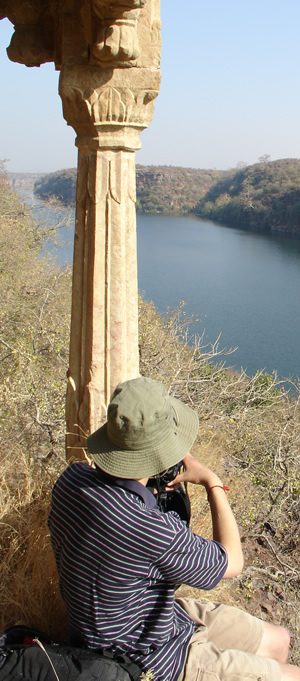
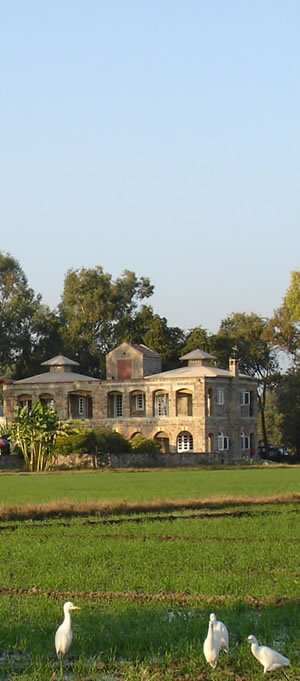
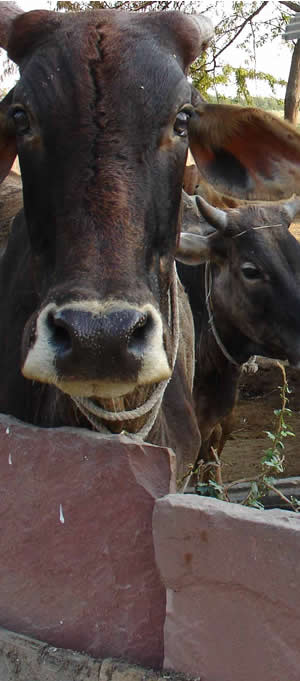
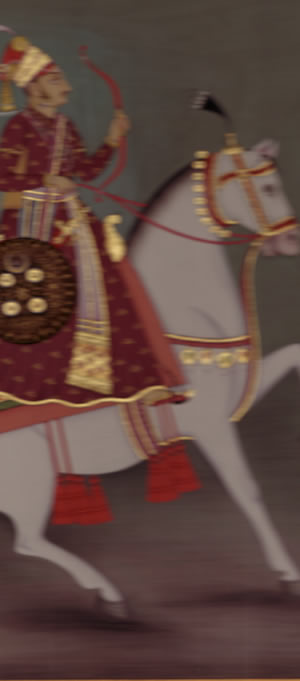
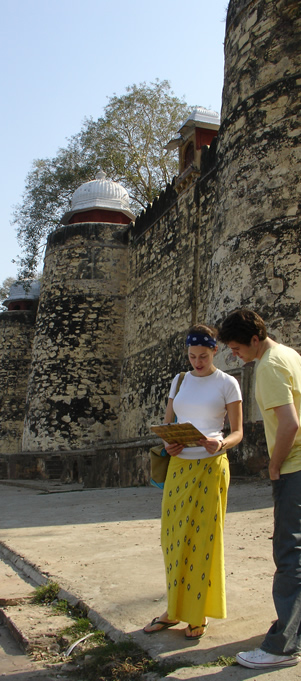
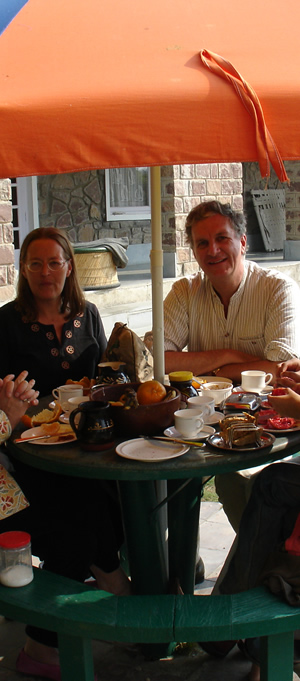
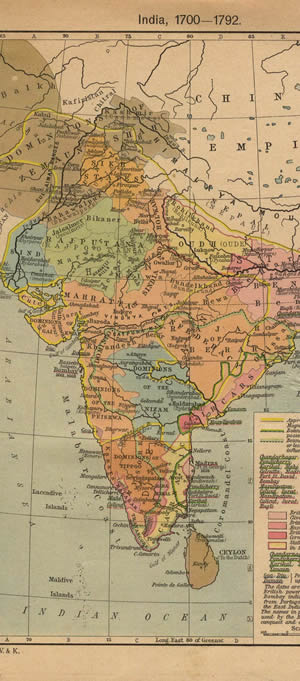
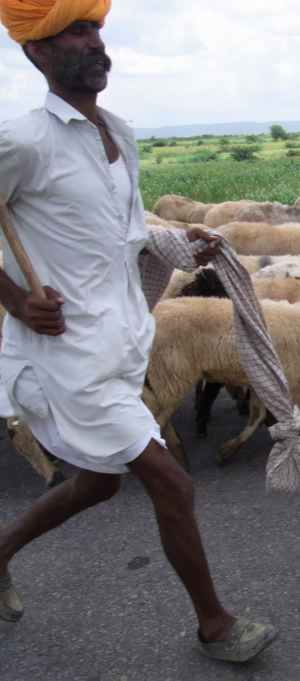
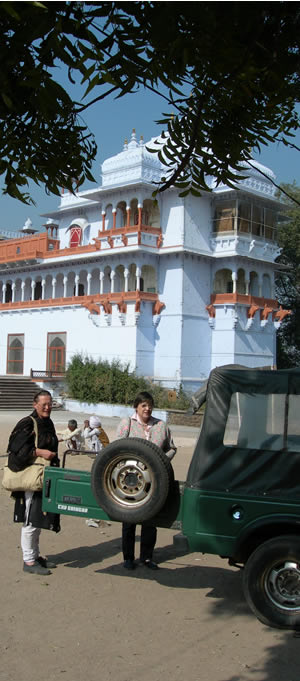
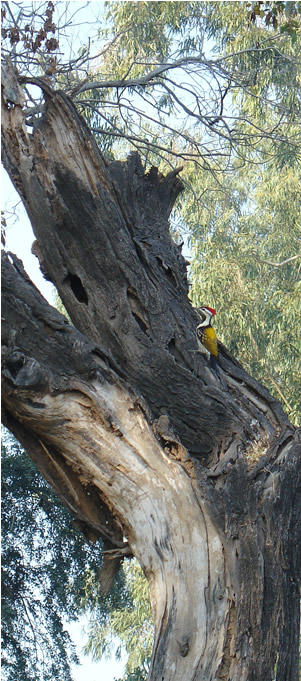
Snippets from the Visitors' Book
The Kota tonga trail was a real highlight - a bit like a 19th Century treasure hunt. It’s full of little nuggets of unusual information and fascinating glimpses into the unsolved mysteries of Kota.
Harriet and Will, London. UK
The memorial to Major Burton and his sons was much more moving than the Taj Mahal or the lake at Udaipur, marvellous as they are.
Henry Vane, Cumbria, UK
...the most comfortable bed I’ve slept in for 2 months....
Charlotte Adam, Winchester UK
Two days out of the noise and the people in a beautiful place. We felt totally
at home
- To be recommended to every person who wishes to experience the Indian country life. We also liked the way the food was prepared...
Patrick & Marie-Christine Lemaigre, Nil-St Vincent, Belgium
We’re only here for the porridge and home made bread! Thank you for a most wonderful time the memories of which we shall carry always. You have given us a wonderful & fascinating introduction to India.
Sue Turner, Lancashire, UK
So ...Rajasthan is not all desert! Thank you for sharing everything with us....
The Read family, London, UK
What a wonderful time we’ve had at the school in the village, at the weavers’, on the river, atop a tonga! Thank you for all your help and contacts throughout India
Anne Gerbner, Philadelphia, USA
It was a wonderful stay and thank you for giving us such a positive look at India and Rajasthan.
Salma Goldstein, New Jersey, USA
- There once was a lady of Kota
- Who took visitors out in her motor
- With the roads and the ruts
- It took quite some guts
- To go out with the lady of Kota.
- But once back at home on the farm
- The world quite descended to calm
- With the plants and the birds
- And fox terriers in herds
- There was balm in the calm on the farm.
Sue Millar, London, UK
After travelling around Rajasthan for two weeks, reaching a real house with books on the shelves, photos on the walls and four happy dogs was simply wonderful.
Camille Savinien, Paris, France
This isn’t tourism. I know of nowhere else where you can experience the real India as well as on your traditional working Rajasthani farm.
Sam Milward, Wellington, New Zealand
Thank you so very much for such a wonderful stay - what a fantastic introduction to India. I don’t think we’ll find such tranquillity elsewhere.
Lizzie Fortune, Hampshire. UK
Fabulous - I’ve been spoilt. It’s hard to leave and face the real world.
Elisabeth Simson, Isle of Wight, UK
After travelling around Rajasthan for two weeks, reaching a real house with books on the shelves, photos on the walls and four happy dogs was simply wonderful.
Camille Savinien, Paris, France
This isn’t tourism. I know of nowhere else where you can experience the real India as well as on your traditional working Rajasthani farm.
Sam Milward, Wellington, New Zealand
Thank you so very much for such a wonderful stay - what a fantastic introduction to India. I don’t think we’ll find such tranquillity elsewhere.
Lizzie Fortune, Hampshire. UK
Our visit at the farm was truly wonderful, off the beaten track it is a slice of India a visitor does not normally experience. Victoria is very knowledgeable about Indian culture and the people - an added perspective for us. The food here was very delicious: organically home grown ingredients, vegetables, fruits, grains prepared simply homestyle. A nice change from curries. Enjoyed the early morning boat ride and walk to the weavers. Many thanks.
Johanna Janssens, Washington, USA
I loved staying with you and the dogs and playing with the toys.
Jonas aged 8, Switzerland
A very welcome break from the crazy world of India – wonderful house, food and hospitality. Thank you so much.
Katie Buxton, Bath, UK
I loved seeing the crocodiles, and I learned a lot about deticking the puppies. Coming to the farm was a great experience.
Stella Bartholet, Washington, USA
A wonderful eye opening visit in every sense. We will be back! Thank you!
Christopher & Joanna Hobson, Northamptonshire, UK
A blissfully peaceful stay. We enjoyed everything – even the power cut. Thank you for lovely food, good company and very interesting trips.
Vicky Stark, London, UK
Exactly what we hoped for and more, bits of India off the tourist track, life as it actually is in villages, teeming life and livestock and the magic of the river.
Sir Hilary Miller, Worcester, UK
Thank you for the introduction to miniature painters, wall paintings, stories, great food, good company, walk through the fields. I loved the paintings in the City Palace and go back full of inspiration and memories.
Nan Mulder, Edinburgh, UK

On the Farm - 2010 Archive
On the Farm - December ’10
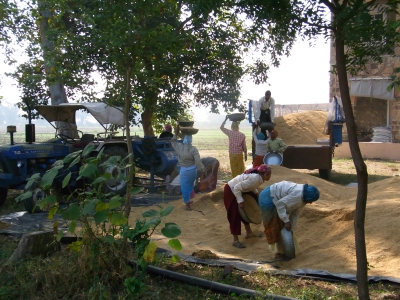 Using another machine attached to the tractor, the women winnowed the rice. The loose sari of one woman became entangled in a spindle and she was dragged towards the moving parts. Luckily, Gharsi managed to turn off the engine and Kali Bai escaped with only minor injuries but was badly shaken.
Using another machine attached to the tractor, the women winnowed the rice. The loose sari of one woman became entangled in a spindle and she was dragged towards the moving parts. Luckily, Gharsi managed to turn off the engine and Kali Bai escaped with only minor injuries but was badly shaken.
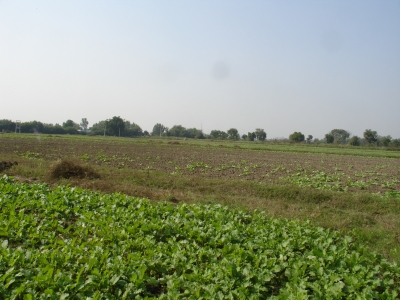 Mustard had been sown in November, but germination was very patchy. Here you can see a good field with a patchy one behind it. Half of the mustard had to be ploughed in and replanted with wheat.
Mustard had been sown in November, but germination was very patchy. Here you can see a good field with a patchy one behind it. Half of the mustard had to be ploughed in and replanted with wheat.
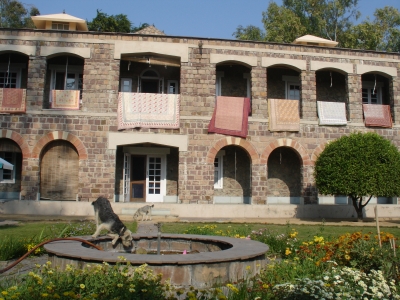 This year the weather is cooling down before Christmas and it was time to air the winter quilts in the hot mid-day sunshine. In the photograph, something in our pond has caught the attention of our dog Tigger. Now as the year-end approaches, the farm is looking fresh and verdant with fields of young wheat which will need watering three times, one field of coriander with its distinctive aroma, and some flowering mustard also scenting the air.
This year the weather is cooling down before Christmas and it was time to air the winter quilts in the hot mid-day sunshine. In the photograph, something in our pond has caught the attention of our dog Tigger. Now as the year-end approaches, the farm is looking fresh and verdant with fields of young wheat which will need watering three times, one field of coriander with its distinctive aroma, and some flowering mustard also scenting the air.
The rice was sold on December 8th for a ruinously low price. The pral or rice straw has also sold for a low price as, ironically, most of Rajasthan had an excellent monsoon and so there is no shortage of fodder. While Europe shivers, we are enjoying 8 deg. Celsius at night and 26 deg. Celsius by day.
On the Farm - November ’10
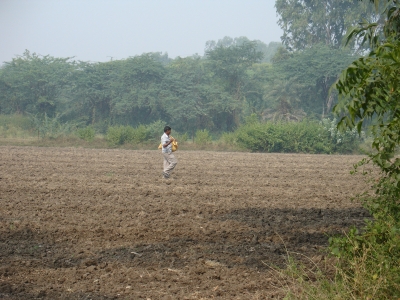
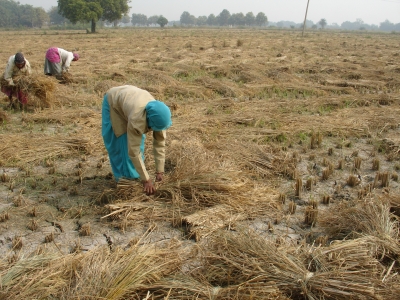
While the women progressed slowly, cutting and tying the harvested rice bundles, the bersim (like alfalfa)seeds were broadcast to provide fodder for the cows. Bersim is a very important source of green fodder for our cows.
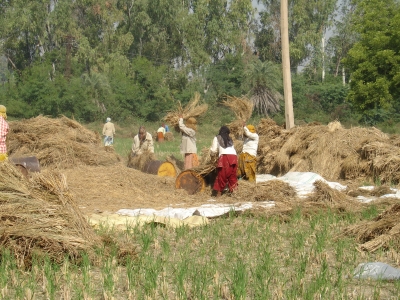 By November 20th the women began threshing by first hitting each bundle against an empty oil drum four or five times. We were able to cover the piles of rice from this point and protect the crop against heavy rain. The rain led to delays and resulted in re-sprouting of the stalks of paddy that you can see as fresh green shoots. Threshing using a machine began on the 27th. Because of the rain, the grain market was in disarray and a lot of bags of grain were rain damaged there. Far from increasing the price, the wet weather served to depress it. We waited for it to stabilise by keeping our rice on the farm.
By November 20th the women began threshing by first hitting each bundle against an empty oil drum four or five times. We were able to cover the piles of rice from this point and protect the crop against heavy rain. The rain led to delays and resulted in re-sprouting of the stalks of paddy that you can see as fresh green shoots. Threshing using a machine began on the 27th. Because of the rain, the grain market was in disarray and a lot of bags of grain were rain damaged there. Far from increasing the price, the wet weather served to depress it. We waited for it to stabilise by keeping our rice on the farm.
On the Farm - October ’10
On October 1st the four red vented bulbul eggs hatched (see September 2010). The chicks soon outgrew the nest which listed and partially collapsed. We hung a safety net underneath to catch falling chicks and finally placed the remains of the nest in a plastic Amul cheese box. Both parents adapted well to the situation but on October 12th, two days later, the last two fledglings disappeared.
Parents are back to their routine and perching on the bamboo, but no sign of the bairns. (To see a short video clip of the fledglings click here.)
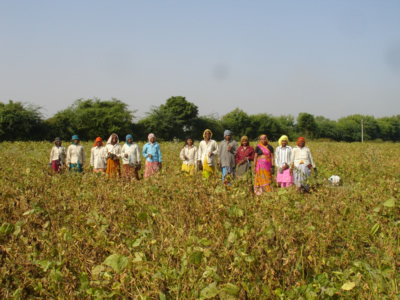 Meanwhile, as the rain had stopped, the paddy was watered continually all month and the soyabean needed one final watering. Soyabean cutting began on October 19th. It was left in small piles to dry for five to six days before threshing.
Meanwhile, as the rain had stopped, the paddy was watered continually all month and the soyabean needed one final watering. Soyabean cutting began on October 19th. It was left in small piles to dry for five to six days before threshing.
Here is the gang that took the soyabean harvesting on contract.
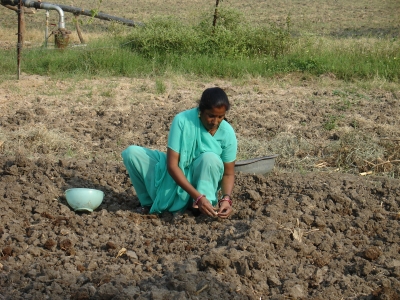 Sugna helped out with the planting of the garlic. The remains of last year’s garlic is divided up and thrust into the soil which should be a fine tilth, unlike the soil seen here.
Sugna helped out with the planting of the garlic. The remains of last year’s garlic is divided up and thrust into the soil which should be a fine tilth, unlike the soil seen here.
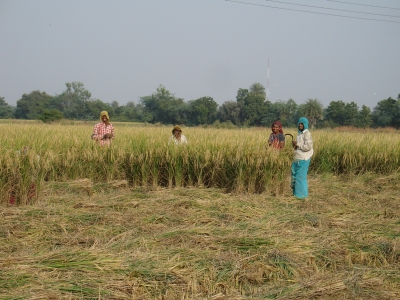 On the last day of October, 7 women started to cut the rice. The Biharis would have cut bundles, tied them and laid them in neat rows. The women cut and dropped them all over the place. It took 6 days to cut and 3 days to tie the bundles, by which time it started to rain.
On the last day of October, 7 women started to cut the rice. The Biharis would have cut bundles, tied them and laid them in neat rows. The women cut and dropped them all over the place. It took 6 days to cut and 3 days to tie the bundles, by which time it started to rain.
On the Farm - September ’10
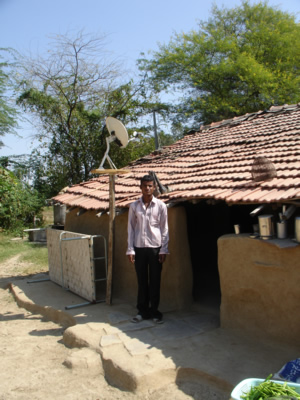 The most interesting sociological farm development was the signing-on of a new type of agricultural worker. 20 year old Ranjit is literate and so is his wife. She is our first ever literate wife but she won't come and live on the farm in the accommodation provided until it has Direct to Home (DTH) satellite colour television with the free 40 channels. Ranjit spent most of his first month’s salary on the necessary equipment and here he is next to his house and his satellite dish. His wife, Asha, still won’t move in as there isn’t room for her wedding dowry, including a large metal cupboard and a cooler....
The most interesting sociological farm development was the signing-on of a new type of agricultural worker. 20 year old Ranjit is literate and so is his wife. She is our first ever literate wife but she won't come and live on the farm in the accommodation provided until it has Direct to Home (DTH) satellite colour television with the free 40 channels. Ranjit spent most of his first month’s salary on the necessary equipment and here he is next to his house and his satellite dish. His wife, Asha, still won’t move in as there isn’t room for her wedding dowry, including a large metal cupboard and a cooler....
Asha refuses to work in the fields or plaster the walls with cow dung and has no obvious way of earning money to help the fledgling household.
Ranjit is a Rajput and wears a wild boar’s tooth around his neck. He is happy to eat meat and drink alcohol but isn’t too keen on hard work and has little agricultural experience. His father works as a tailor and his uncle is our uncle’s cook. He gave up better paid concreting labouring work to come and work here and it’s not clear why except that we agreed to a Rs. 6000 advance repayable over a year.
We had little rain in September, but Delhi which had had rain nearly every day for three months was struggling to get the flooded Commonwealth Games village ready for October 3rd. The river Yamuna was twice so high that trains were not allowed to use the bridge. Delhi came within a whisker of being flooded and it appears that villages upstream were sacrificed by breaching the river to save Delhi and the Games. The water bodies in Hadoti are largely dry but because Delhi had such good rain and western Rajasthan was green and bubbling with water as never before, it will go down in the records as a ‘good monsoon.’
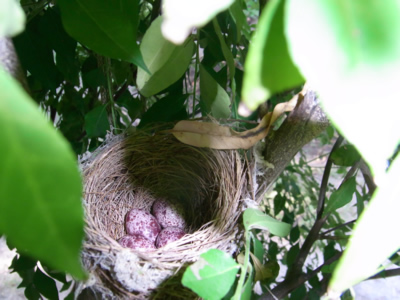 On September 19th a Red Vented Bulbul sat on a small nest 50 cms from a ground floor window. On the 23rd we photographed these 4 pink blotchy eggs.
On September 19th a Red Vented Bulbul sat on a small nest 50 cms from a ground floor window. On the 23rd we photographed these 4 pink blotchy eggs.
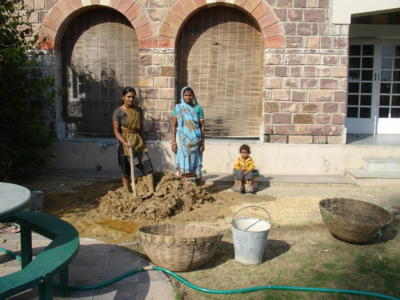 By the end of September the rains had stopped and here you can see the paths around the house being redone for the winter and till the next onset of the monsoon in 2011. Ideal opportunity for young Dashrath to ‘muck in.’
By the end of September the rains had stopped and here you can see the paths around the house being redone for the winter and till the next onset of the monsoon in 2011. Ideal opportunity for young Dashrath to ‘muck in.’
On the Farm - August ’10
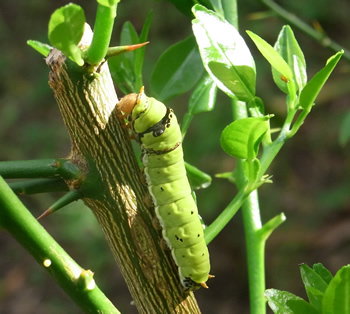 Despite occasional showers the temperature did not fall. Very sweaty and humid conditions prevailed, and it lead to an explosion of beautiful lemon butterflies and their destructive fat green caterpillars which stripped the leaves to the ribs on the citrus trees. For several days we picked-off caterpillars twice a day and drowned them. Finally, heavy rain ended the infestation.
Despite occasional showers the temperature did not fall. Very sweaty and humid conditions prevailed, and it lead to an explosion of beautiful lemon butterflies and their destructive fat green caterpillars which stripped the leaves to the ribs on the citrus trees. For several days we picked-off caterpillars twice a day and drowned them. Finally, heavy rain ended the infestation.
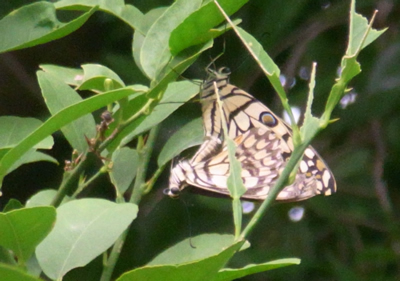 Here two of the butterflies stayed still long enough to mate.
Here two of the butterflies stayed still long enough to mate.
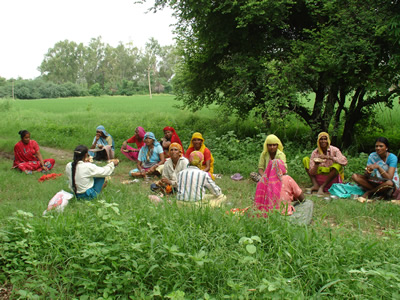 Because so little rice has been planted this year the male migrant Bihari labourers came, saw, and went back, leaving the transplanting and weeding work to the local women who became a very scarce and sought after resource. They weeded our rice, and then later in the month our very lush soyabean. Here the women are sitting and enjoying their lunch break. They bring their cooked food in metal tiffin carriers and create and leave behind no litter. They work through the heaviest of rain showers wearing thin plastic hooded capes. There were frequent short showers through the month but no prolonged rain. We were spared the heavy rain causing havoc in Pakistan.
Because so little rice has been planted this year the male migrant Bihari labourers came, saw, and went back, leaving the transplanting and weeding work to the local women who became a very scarce and sought after resource. They weeded our rice, and then later in the month our very lush soyabean. Here the women are sitting and enjoying their lunch break. They bring their cooked food in metal tiffin carriers and create and leave behind no litter. They work through the heaviest of rain showers wearing thin plastic hooded capes. There were frequent short showers through the month but no prolonged rain. We were spared the heavy rain causing havoc in Pakistan.
On the Farm - July ’10
We were away for most of July but checked regularly to see if the rain had arrived. It hadn’t. Only half the planned rice could be planted as the borewell could not supply water for more, and was just coping. Soya bean was planted and had germinated well.
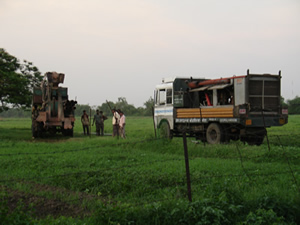
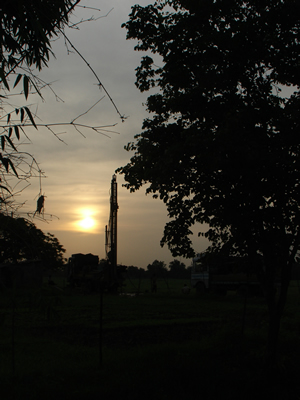
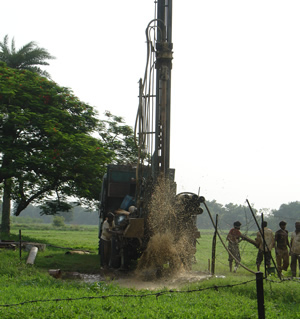 It was decided to drill a deeper borewell so as to lower a pump below its present 42 feet depth as it was proving insufficient for a constant supply of water. Two lorries finally arrived on July 29th after various delays. The team of seven men drilled from 2230 hrs. until midnight and started again at 0545 hrs. the following day. At 0800 hrs. water started gushing out. The new borewell is 142 feet deep of which the first 42 feet is through soil and the rest through rock. The top 50 feet is lined with metal pipe and the pump is suspended 60 feet below ground level. The new borewell, when in operation, now draws so much water that it prevents the old traditonal open well from filling as it used to previously.
It was decided to drill a deeper borewell so as to lower a pump below its present 42 feet depth as it was proving insufficient for a constant supply of water. Two lorries finally arrived on July 29th after various delays. The team of seven men drilled from 2230 hrs. until midnight and started again at 0545 hrs. the following day. At 0800 hrs. water started gushing out. The new borewell is 142 feet deep of which the first 42 feet is through soil and the rest through rock. The top 50 feet is lined with metal pipe and the pump is suspended 60 feet below ground level. The new borewell, when in operation, now draws so much water that it prevents the old traditonal open well from filling as it used to previously.
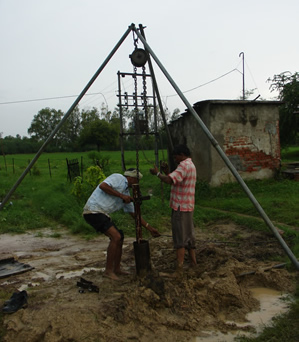 The final stage was to remove the pump from the old borewell using a block and tackle and lower it into the new one. Gharsi Lal and Amar Lal laboured in the rain to finish this last major task.
The final stage was to remove the pump from the old borewell using a block and tackle and lower it into the new one. Gharsi Lal and Amar Lal laboured in the rain to finish this last major task.
The monsoon showers, although light, have transformed the barren summer landscape. The farm now has a green carpet.
On the Farm - June ’10
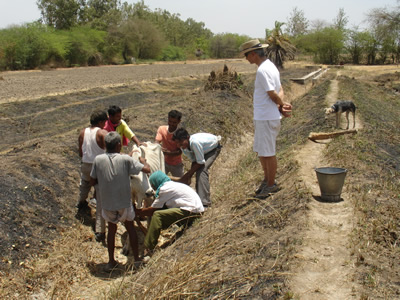 No pre-monsoon showers this year and so very little green fodder. This old and frail cow wandered into the farm looking for food and fell into the dry irrigation channel. It did not have the strength to get up on its own. It took six men to get her standing again. She was gently seen off the farm.
No pre-monsoon showers this year and so very little green fodder. This old and frail cow wandered into the farm looking for food and fell into the dry irrigation channel. It did not have the strength to get up on its own. It took six men to get her standing again. She was gently seen off the farm.
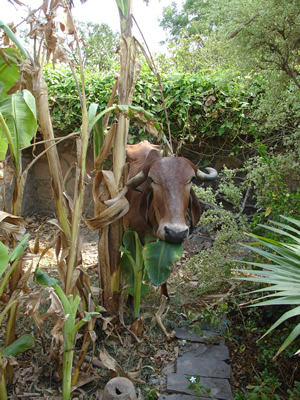 This is our oldest cow. She is 17 and has arthritis and is allowed to wander at will as there are no crops on the farm. She found our banana trees and happily munched on the leaves before she was found out and photographed.
This is our oldest cow. She is 17 and has arthritis and is allowed to wander at will as there are no crops on the farm. She found our banana trees and happily munched on the leaves before she was found out and photographed.
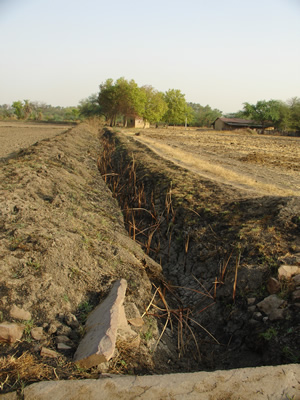
After the wheat harvest the stubble and scrub was burnt, along with some green vegetation quite unintentionally. These were luxurious bull rushes.
On the Farm - May ’10
Very hot and dry with temperatures up to 48 degrees Celsius for the first time ever for me. 48 degrees Celsius feels like being in a fan-assisted oven, but we were able to go swimming at 7 a.m. at the Kota Club nearby when the temperature was a mere 35 degrees.
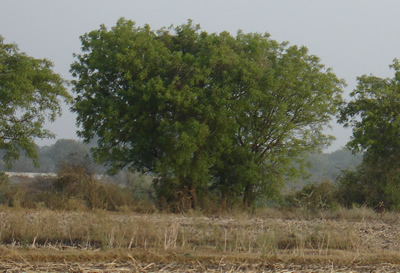
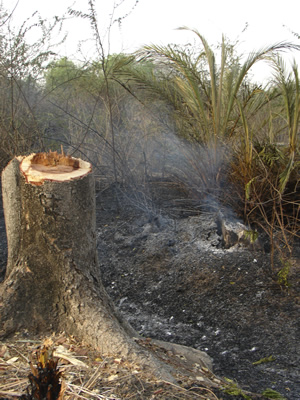 The jungle next to us has been cleared for farming and we can now see through the hedge to the boundary wall at the other side of the Government Farm. The wilderness used to be home to numerous wild boar, monkeys, nilgai, and birds. Now they have been forced from being east of us to the west of us, which used to be a large forested area but is daily under attack from the tree cutters. No one seems willing to take action, least of all the police. It is illegal to cut trees. While Nagar Nigam, the municipal body, encourages people to plant trees in town, they are ignoring the loss of mature trees on their own land.
The jungle next to us has been cleared for farming and we can now see through the hedge to the boundary wall at the other side of the Government Farm. The wilderness used to be home to numerous wild boar, monkeys, nilgai, and birds. Now they have been forced from being east of us to the west of us, which used to be a large forested area but is daily under attack from the tree cutters. No one seems willing to take action, least of all the police. It is illegal to cut trees. While Nagar Nigam, the municipal body, encourages people to plant trees in town, they are ignoring the loss of mature trees on their own land.
On the Farm - April ’10
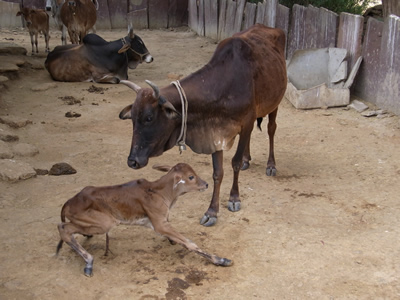 March was unusually hot this year and the wheat ripened earlier and was smaller grained. This meant that it weighed less. The rates of hand cutting the wheat have gone up to 54 kgs. per bigha. This amounts to one-tenth of the yield on poor land and so we were glad to be able to book a combine harvester. The combine rate had actually gone down on last year’s as there were more of them about. You can see fleets of them arriving from the Punjab.
March was unusually hot this year and the wheat ripened earlier and was smaller grained. This meant that it weighed less. The rates of hand cutting the wheat have gone up to 54 kgs. per bigha. This amounts to one-tenth of the yield on poor land and so we were glad to be able to book a combine harvester. The combine rate had actually gone down on last year’s as there were more of them about. You can see fleets of them arriving from the Punjab.
On April 9th a male calf was born to Chambal and so was named Parwan after a tributary of the River Chambal. Here he is struggling to get up within minutes of being born.
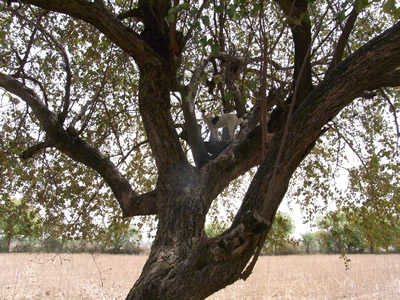
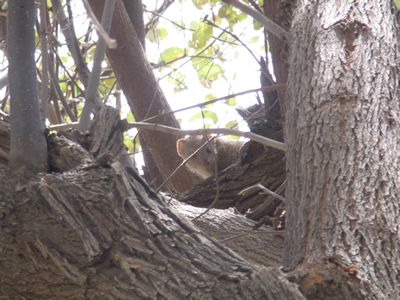
The unusual photo for this month is of our dog Anjelica up a tree where she climbed in pursuit of a mongoose.
And here she is with her two six-month old ‘puppies’ Tigger, so named for his bounciness, and Misty.
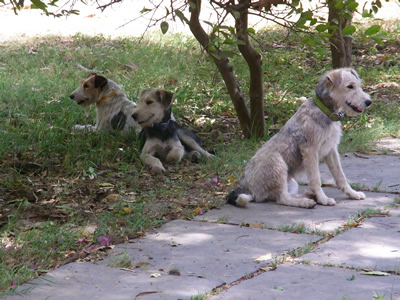
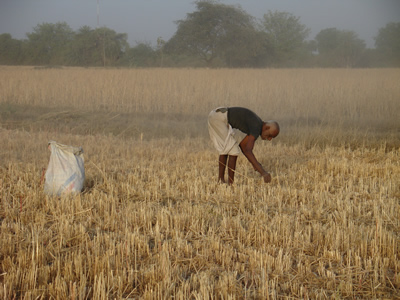
And after the wheat harvest, the lone gleaner picked-up heads of wheat.
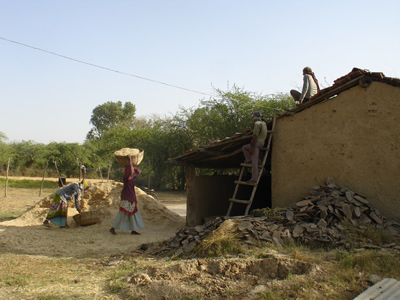 The valuable wheat chaff or bhoussa, which is needed as cattle fodder, was loaded in the fields into a tractor trolley basket-by-basket, and dumped into a pile near the bhoussa house, to be filled through the roof by a team of four working mainly by night to escape the sun’s heat.
The valuable wheat chaff or bhoussa, which is needed as cattle fodder, was loaded in the fields into a tractor trolley basket-by-basket, and dumped into a pile near the bhoussa house, to be filled through the roof by a team of four working mainly by night to escape the sun’s heat.
On the Farm - March ’10
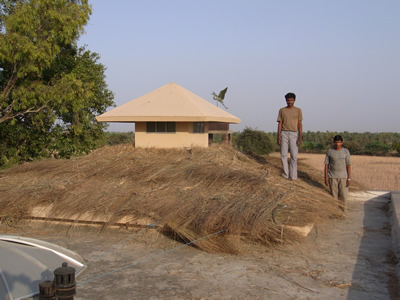
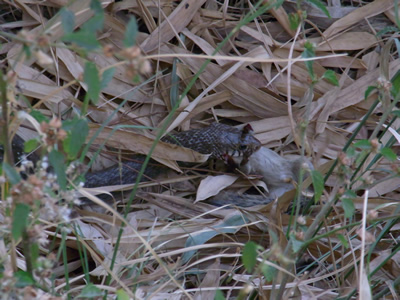
This year we are trying out tying thatch to the sloping parts of the roof expecting it will lessen heat absorption and keep the interior a little cooler.
Vijay was able to photograph this extraordinary sight of a rat snake eating a live gileri or squirrel. This happened when we were just setting off for our daily evening stroll around the farm.
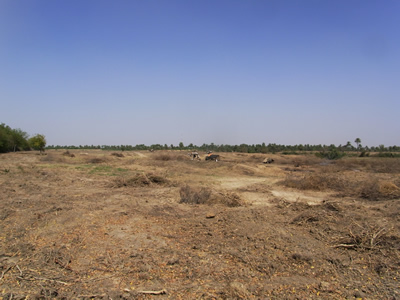
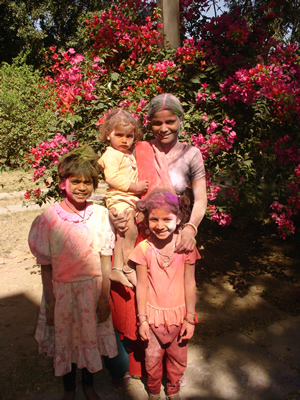
Our farm shares a hedge-and-tree border with a Government run agriculture university, which was bush and jungle on both sides of a small seasonal river. They have now given that land for farming and all the trees and scrub are being cleared. A wall will be erected between our farms which will keep stray cows out but will hinder the movement of some wild life. The monkeys from the scrubland side have relocated to another Government owned wilderness on the other side of us, which is well wooded and now houses a sewage treatement plant, which is sitting idle, waiting for the sewage from Kota city to be connected up.
We were fined for farming a large tract of government land somewhere in the distance at the top of this photograph, but using Google Earth and its pretty accurate ruler tool we were able to show quite easily to the revenue authorities that they were in error. They undertook a visual survey of the area and acknowledged it was a mistake.
This year for Holi we had Canadian guests who were able to join in the dry powder fights. Here is Sita with her son in her arms, a young relative nanny brought from the village to look after him while she harvested mustard, and her niece.
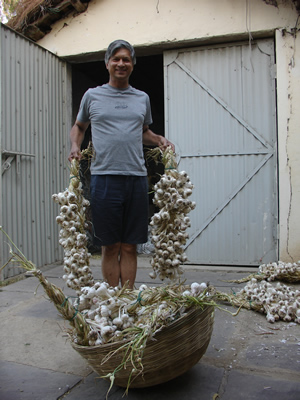 This is the garlic harvest from our vegetable garden. The garlic was also distributed to the employees. None of it was sold.
This is the garlic harvest from our vegetable garden. The garlic was also distributed to the employees. None of it was sold.
On the Farm - February ’10
Again watering the wheat was the main occupation. A cable holding up the submersible pump snapped and it took four men to haul it out and put a new cable. We sorely need a racheting tool to do such hauling-up of loads.
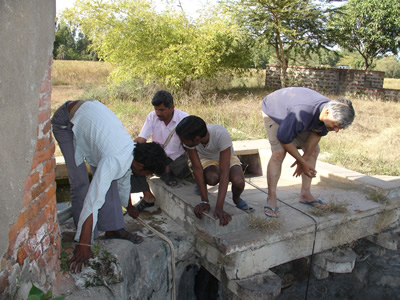
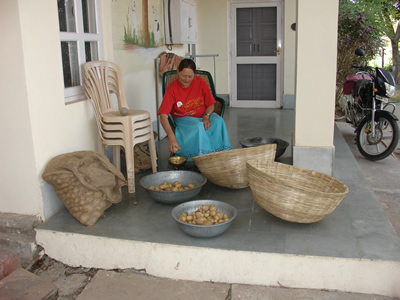
The potatoes were harvested from the vegetable garden. There are too many of us as they won’t keep through the monsoon. Here I am weighing them 500g at a time to share with the farm workers, and Sugna the house help.
While defending the farm Anjelica, our dog, was badly mauled by unknown dogs or pigs and had a deep gash to her neck which took several weeks to heal.
The mustard was hand cut by contract workers in their bright clothes. And while the mother’s worked, grandfather, affectionately known as Pitaji, looked after the children.
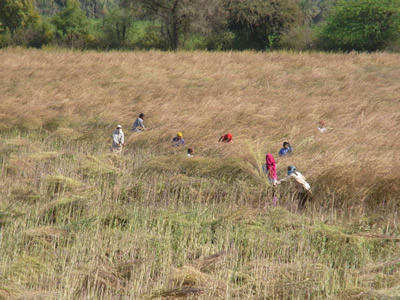
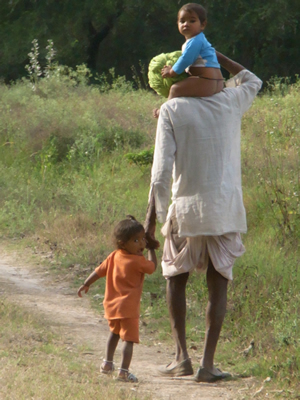
On the Farm - January ’10
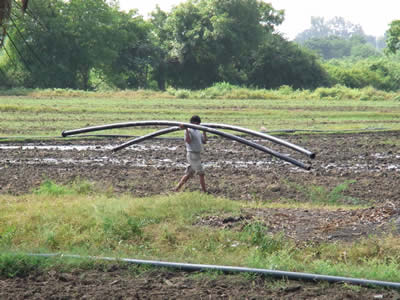 The main occupation on the farm is watering. Because of poor rains, the canal system closed early and farmers relied on plastic pipes and bore holes.
The main occupation on the farm is watering. Because of poor rains, the canal system closed early and farmers relied on plastic pipes and bore holes.
There was a lot of damage to the young wheat and mustard by nilgai and wild pigs. With so much land being watered, January saw a lot of days with dripping fog. The sun didn’t get through till mid-day. We have never had this sort of murky weather before that affects the Gangetic Plain every winter.
On January 15th there was a solar eclipse which we were able to view by projecting the image onto a cardboard using binoculars.

